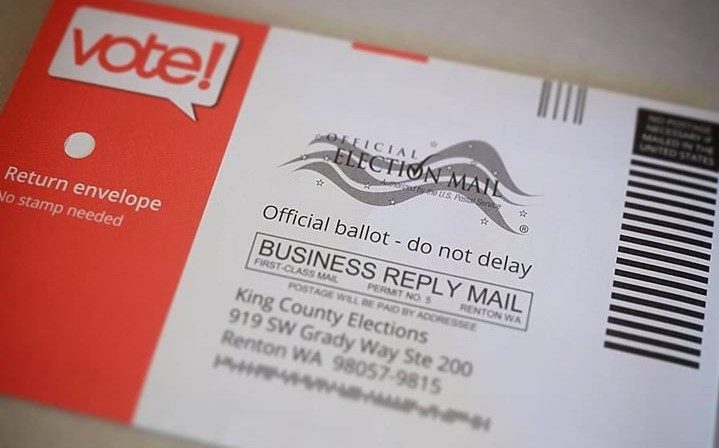How Do We Vote in the Corona Era?
Washington – Okay, America, how do we vote in 2020 with coronavirus facing us?
Wisconsin chose to bull ahead – stick with its April 7 date and in-person voting. Democratic Governor Tony Evers proposal the state put off the primary until June or at least make it all vote-by-mail. But Republican leaders in the legislature refused to compromise. Any delay or change, they said, would cause confusion and chaos.
With public health his top priority, Evers issued an executive order to postpone the election, but he was blocked by the Wisconsin Supreme Court which ruled that the state legislature, not the governor, has the legal power to set election dates. The legislature gave the Go Ahead, even though 111 cities and towns lacked enough workers to operate the polls. Milwaukee could only open 5 of 180 polling sites.
Election Day was a fiasco — poll workers in hazmat suits, voters in masks, stretched out in long lines to play it safe. Turnout was low – 18,803 in Milwaukee, compared to 167,000 in 2016. “This is ridiculous,” said the sign of one unhappy voter. Others complained that they had to vote in person because they never got the absentee ballots that they had requested “No one should have to choose between risking their health and possibly dying and going to vote,” complained 31-year-old Milwaukee County supervisor Marcelia Nicholson.
Eight States Shift to Voting-at-Home
But Wisconsin is the oddball. The governors of 15 other states, Republicans as well as Democrats, postponed their April elections and eight of those – Alaska, Idaho, Indiana, Montana, Nevada, New Jersey, Ohio, and Wyoming – took the bold step of declaring their elections would be conducted entirely by mail.
Five additional states – Georgia, Iowa, Michigan, Nebraska and West Virginia – plan to encourage and facilitate Voting-at-Home by automatically sending applications for “no excuse” absentee ballots to all registered voters. Five more states – Delaware, Massachusetts, New Hampshire, New York and Vermont – still require voters to ask for absentee ballots but they have added the corona virus to the list of acceptable excuses for absentee voting.
Which States Are Using Voting by Mail in 2020?

Sources: Ballotpedia, The New York Times, state government websites, and local journals
“The right of citizens to elect their leaders in a free and open election is one of the cornerstones of America,” asserted Indiana’s Republican Governor Eric Holcomb. “In order to balance that right with the safety of county employees, poll workers and voters,” Holcomb decreed the primary would be delayed and held 100% by mail, instead of voting in person. Other governors concurred. “I urge all voting Idahoans to request their absentee ballots as soon as possible so they can vote from home this year,” declared Idaho’s Republican Governor Brad Little.
New Poll: 72% Majority Favor Voting by Mail
Mail-in voting, or as some call it, “Voting at Home,” is the new mantra for 2020, touted by long-time advocates of election reforms, who contend that mail voting will not only protect people’s health but will increase turnout. They point to the higher-than-average turnout typically achieved by the five states that already do their elections by mail – Colorado, Hawaii, Oregon, Utah and Washington, plus California where many counties adopted all mail voting, well before COVID-19 showed its ugly face.
It’s a move apparently favored by most Americans. A nationwide poll, taken in early April by Reuters/Ipsos found that 72% of adult Americans supported a requirement for mail-in ballots in the November election to reduce the health risks. What was striking was while a poll taken earlier in the coronavirus spread showed some partisan differences, the new poll found strong support for mail voting across the political spectrum with 79% of Democrats and 65% of Republicans in favor.

President Trump clearly sees mail voting as a threat to him and the GOP. If it is widely adopted, he wailed, “You’d never have a Republican elected in this country again.” Even though he personally voted by absentee ballot in the Florida primary last month and he offered no evidence for his accusations, Trump inveighed against absentee voting on the eve of the Wisconsin primary. “Mail ballots are a very dangerous thing for this country, cause they’re cheaters,” Trump declared. “They go and collect them They’re fraudulent in many cases.”
Contrary to Trump’s assertions, no significant cases of absentee voter fraud have surfaced in the five states that now regularly use mail voting for their elections. The most high profile recent case of “vote harvesting” involved campaign workers for a Republican congressman in North Carolina in a 2018 election, which was voided by the state elections board and the perpetrators were jailed.
Corona Price-Tag: Modernize US election system for $2 Billion
What’s more, it’s too late to turn back the clock. Voting by mail is already so embedded in American elections that nearly one quarter of the electorate, or 30 million voters, cast mail or absentee ballots in the 2016 presidential election, Trump’s election, and obviously, more is coming – soon.
Some reform groups such as RepresentUs want to go for broke. They advocate a nationwide shift to voting by mail this year and they’re lobbying members of Congress for a federal law mandating voting by mail all across the country. But more pragmatic reformers say that’s too fast to be practical and some voters prefer to vote in person. To them, state-by-state change is the better route, and the most urgent task is to modernize the voting infrastructure at the state level to cope with the expected avalanche of corona-spurred mail voting.
A new study by the nonpartisan group Unite America found that most states are ill-prepared and ill-equipped. Except for the five states that are set up for 100% mail voting, most states typically get only about 10-15% of their total vote by mail.” It’s a very manual process,” explains Tyler Fisher, Unite America’s deputy director. “People fill out application forms by hand, They are processed by hand. Absentee ballots are sent out by hand. So election administrators don’t have the infrastructure in place to handle the anticipated surge as a result of coronavirus.”
 In short, our system is not up to the job it now faces. To ramp up capacity, the reform coalition known as the Declaration for American Democracy is pressing Congress to appropriate $2 to $4 billion for election aid to the states in the next corona relief package. Congressional Democrats are signing on. Question is: Will congressional Republicans, like Trump, buck the corona tide?
In short, our system is not up to the job it now faces. To ramp up capacity, the reform coalition known as the Declaration for American Democracy is pressing Congress to appropriate $2 to $4 billion for election aid to the states in the next corona relief package. Congressional Democrats are signing on. Question is: Will congressional Republicans, like Trump, buck the corona tide?
According to vote specialists at New York University’s Brennan Center for Justice, at least $2 billion is needed both for election security against hacking and for state election systems to afford to print, mail, receive and track the process of mail balloting and to hire more staff to handle the workload.
“The virus presents a real and present danger to our democracy,” asserts Unite America. “Voter participation is a bedrock of a representative government, but voters should not be forced to assume a health risk to cast their ballots. The primary solution is the expansion of a tested, non-partisan reform already in place in many states – access to vote at home.”
In corona times, it’s a message with real appeal to millions of voters.


 Hedrick Smith, who conceived this website and is its principal writer and architect, is a Pulitzer Prize-winning former New York Times reporter and Emmy award-winning documentary producer for PBS and PBS FRONTLINE.
Hedrick Smith, who conceived this website and is its principal writer and architect, is a Pulitzer Prize-winning former New York Times reporter and Emmy award-winning documentary producer for PBS and PBS FRONTLINE. 


